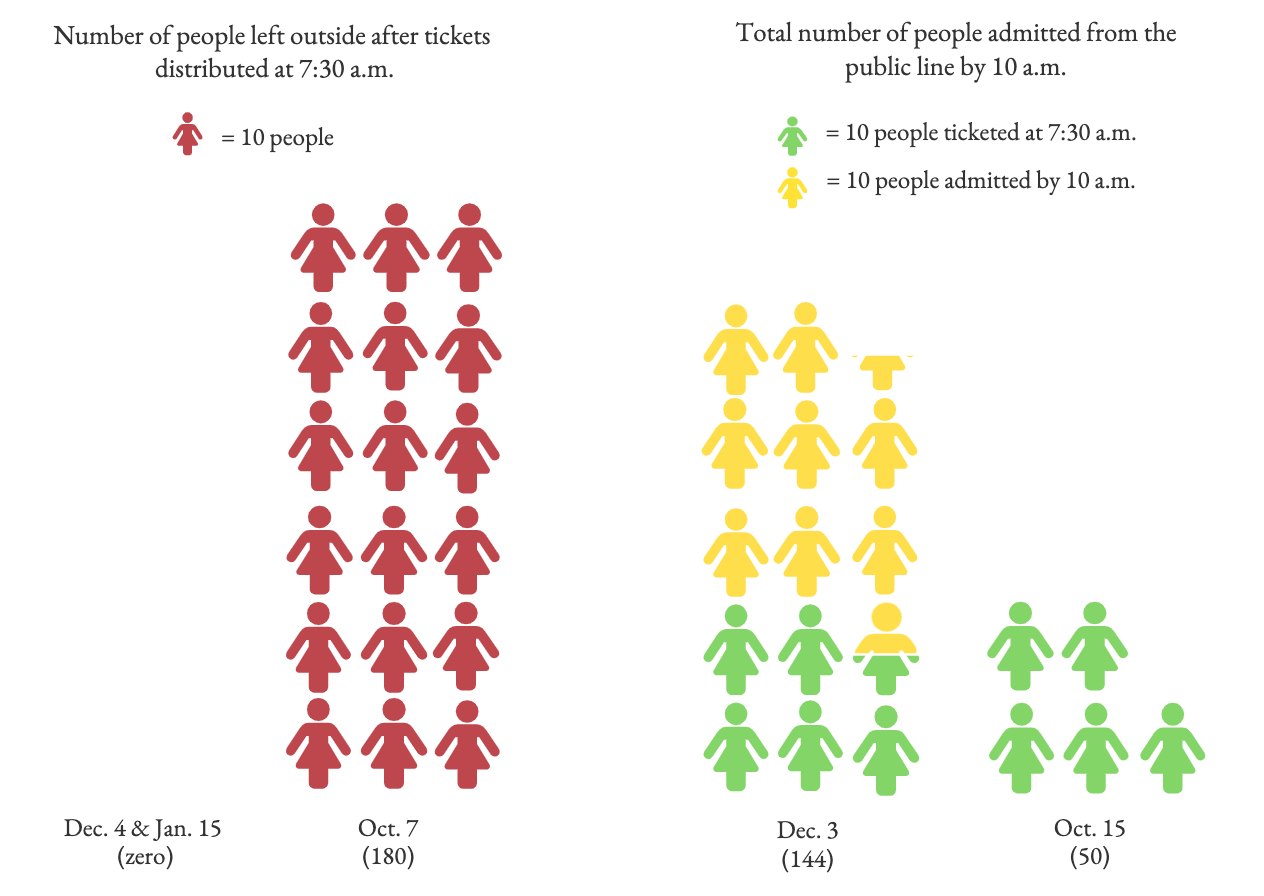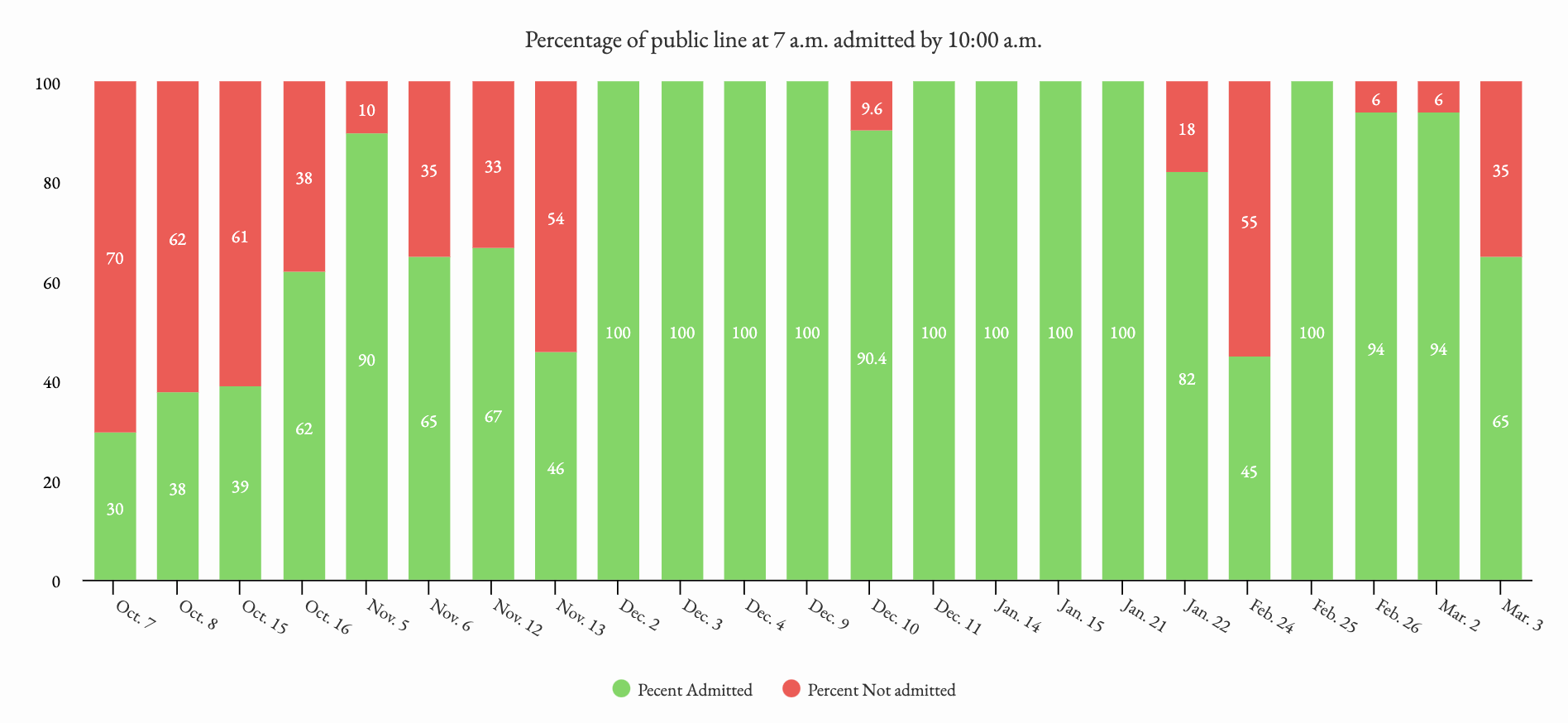Courtroom access: Let’s talk data – the public line

on May 4, 2020 at 6:47 pm

This post is based extensively on data collected by Casey Quinlan, Kalvis Golde and Katie Bart and analyzed and put into graphic form by Kalvis Golde and Katie Bart.
It’s one of the questions we get most often at SCOTUSblog, and it’s one of the hardest to answer: When should I get in line for a seat in the courtroom? Trying to predict when someone needs to arrive to ensure a seat is more art than science, depending on factors such as the cases being argued, the time of year and even the weather. Add in the fact that a key variable – exactly how many tickets will be available for members of the public – is shrouded in mystery, and it gets even more complicated. To try to shed some light on this process, SCOTUSblog tracked the distribution of tickets to the public line for every in-person argument session this term. The data that follows may not be a perfect predictor of when someone should get in line once the justices resume in-person arguments, but we hope it will be useful. Perhaps just as importantly, the data also helps to demonstrate the immense public interest in the court’s oral arguments – and how the system in place this term often fell short of meeting that interest.
1. When did people need to arrive?
The Supreme Court normally guarantees that at least 50 of the 439 seats in the courtroom are reserved for members of the public. Tickets for those seats are distributed at approximately 7:30 a.m. on the morning of an argument session. From October through the first week in March, the median time to show up to get the last ticket handed out at 7:30 was shortly before 5:30 a.m. (To be clear, the first person in line would likely have arrived well before that, as some of the stories in this series have chronicled. But for purposes of collecting data, we also focused on the time at which someone could have arrived and still secured a seat in the courtroom.) A 5:30 a.m. arrival time would mean spending two hours on the sidewalk before the tickets are distributed, followed by 2.5 more hours inside the Supreme Court building waiting for oral arguments to begin – all together, an investment of 4.5 hours, not counting transportation to the Supreme Court, before the oral arguments even start.
On four different days this term, a member of the public who wanted to attend arguments would have had to arrive long before 5:30 a.m. to get one of the 50 tickets distributed at 7:30 a.m. Three of those argument sessions featured some of the biggest cases of the term, as the justices weighed whether Title VII of the Civil Rights Act protects LGBT employees (required arrival time: 35 hours before tickets were distributed); whether the Trump administration acted properly in ending the program known as DACA (23 hours in advance); and a challenge to a Louisiana abortion law (24 hours in advance). A dispute over efforts to build a natural-gas pipeline that would cross underneath the Appalachian Trail did not have quite as high a profile, but it too resulted in long lines outside the court, requiring an arrival eight hours in advance.
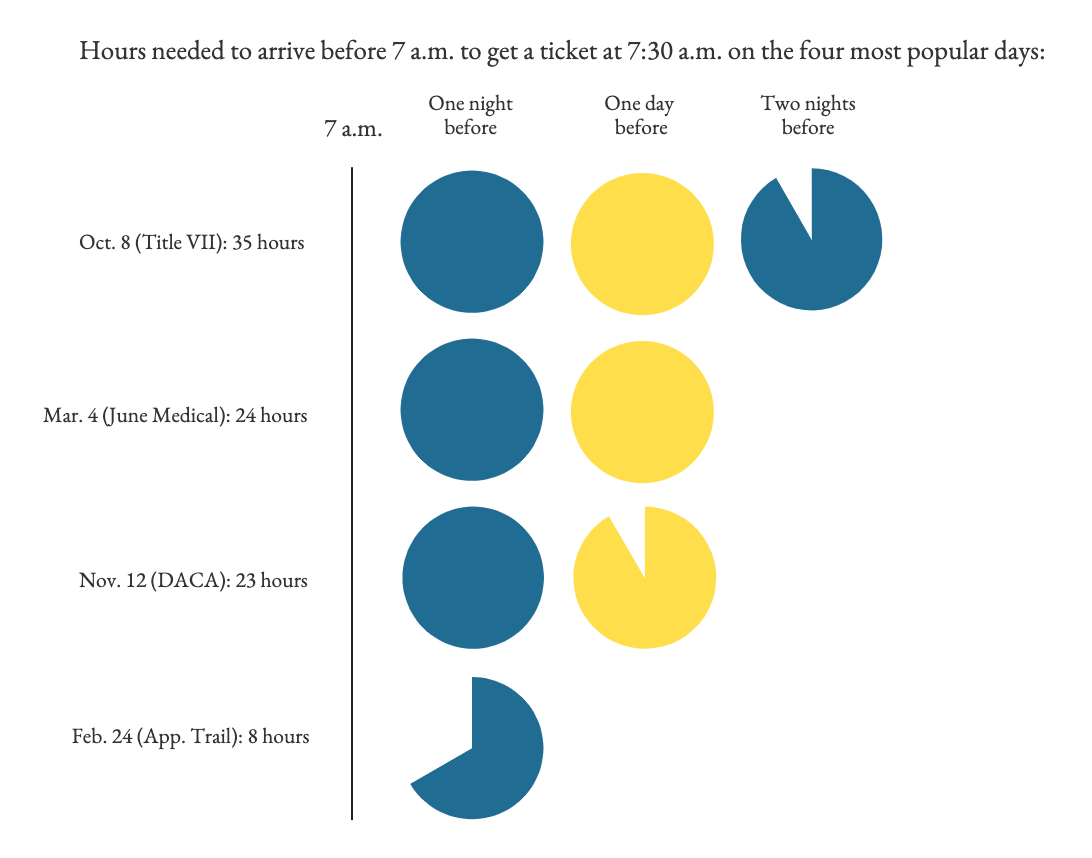
The initial set of tickets is distributed around 7:30 a.m., but normally the people who are left standing in line still have another shot at getting a seat in the courtroom: Shortly before 10 a.m., the Supreme Court police will usually let more people in for the oral arguments – presumably, after the officers have a better sense of how many additional public seats are available once other guests of the court with reserved seats have arrived. For most arguments, the people admitted in this group generally arrive later and spend less time waiting in line: In October, November and February, you could often arrive shortly before 7 a.m. and still get a seat with the 10 a.m. group. In December and January, when the weather was colder, you could often show up much later – shortly before 10 a.m. – and still secure a seat. But trying to get a seat as part of the “second wave” at 10 a.m. involves a lot more uncertainty than getting one of the tickets distributed at 7:30 a.m. 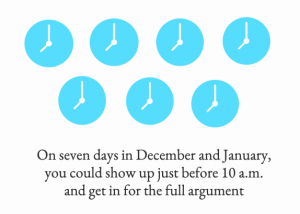 Indeed, our observations suggested that, based on the original lines, you would have theoretically had to arrive fairly early to get a seat at some of the high-profile arguments in December and January as well. But the Supreme Court police officers are rarely able to provide much information about the likelihood of getting a seat after the initial set of tickets has been distributed, and you run the risk of striking out after spending additional time waiting in line – which, as we will describe below, may prompt some people to give up.
Indeed, our observations suggested that, based on the original lines, you would have theoretically had to arrive fairly early to get a seat at some of the high-profile arguments in December and January as well. But the Supreme Court police officers are rarely able to provide much information about the likelihood of getting a seat after the initial set of tickets has been distributed, and you run the risk of striking out after spending additional time waiting in line – which, as we will describe below, may prompt some people to give up.
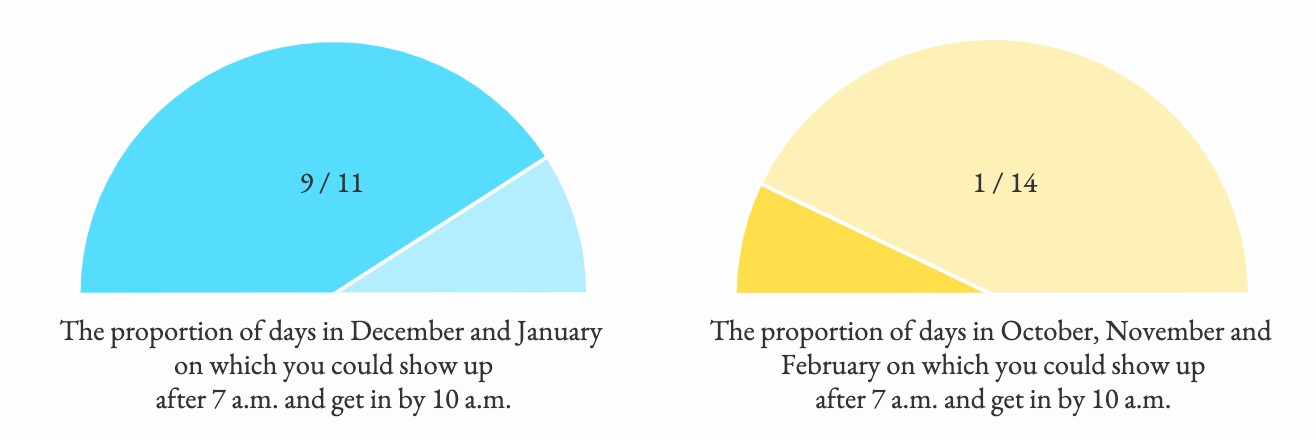
On the one day in the second chart on which we project that you could have arrived after 7 a.m. and gotten in, October 8, a bomb scare scattered the line after tickets were distributed; the line was significantly shorter when it reconvened. We were not able to obtain full data on the line on March 4, a high-profile abortion argument.

The number of people left in the public line after tickets were handed out at 7:30 a.m., in the warm October weather (yellow) versus the cold December and January weather (blue). Incomplete data collected on January 14.
2. How many people got in?
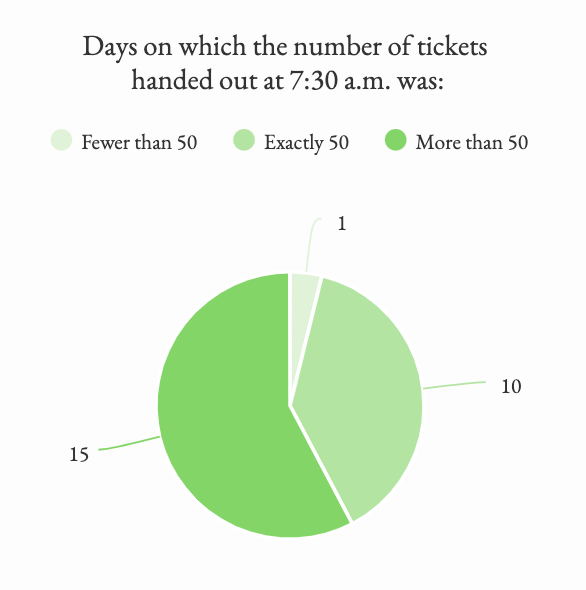 On most argument days, the Supreme Court police handed out roughly 50 tickets at 7:30 a.m. – and exactly 50 tickets on 10 days. Of the days on which there were at least 50 people in line when the police began to hand out tickets at 7:30, there was only one on which the court distributed fewer than 50 tickets: December 10, when the justices heard oral argument in a trio of consolidated cases involving the government’s failure to fully reimburse health-insurance companies for losses that they suffered under the Affordable Care Act. On six days, the Supreme Court police handed out more than 55 tickets at 7:30; the biggest day was November 6, when the officers distributed 73 tickets.
On most argument days, the Supreme Court police handed out roughly 50 tickets at 7:30 a.m. – and exactly 50 tickets on 10 days. Of the days on which there were at least 50 people in line when the police began to hand out tickets at 7:30, there was only one on which the court distributed fewer than 50 tickets: December 10, when the justices heard oral argument in a trio of consolidated cases involving the government’s failure to fully reimburse health-insurance companies for losses that they suffered under the Affordable Care Act. On six days, the Supreme Court police handed out more than 55 tickets at 7:30; the biggest day was November 6, when the officers distributed 73 tickets.
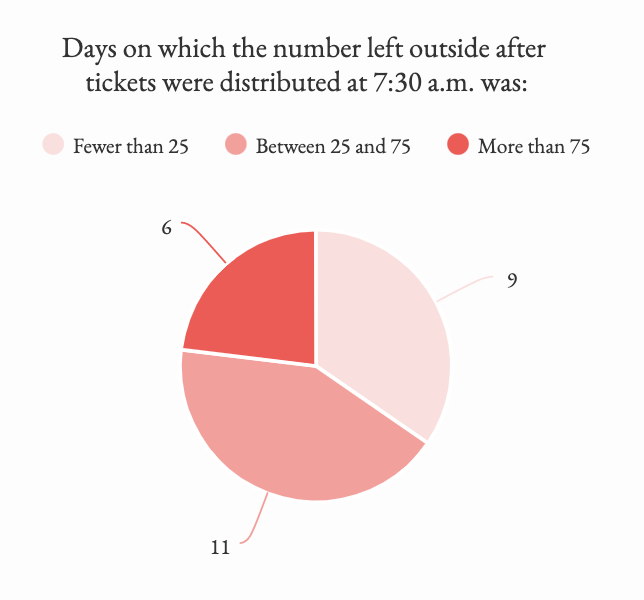 On most days, particularly in the fall, the distribution of tickets at 7:30 a.m. left many people disappointed. Over the course of the term, the median number of people who did not get tickets at 7:30 was 36. There were 10 days in total on which there were more than 50 people left outside after the tickets were distributed at 7:30. On the first day of the term, 180 people remained in line after the first set of tickets was handed out; on February 24, for the oral argument in the Appalachian Trail case, there were 174 people still in line after the 7:30 tickets were distributed. There were two other days on which there were more than 100 people in line after 7:30: October 8, for the arguments in the Title VII cases, and November 13, when the justices heard oral argument in a case involving the federal law banning racial discrimination in contracts.
On most days, particularly in the fall, the distribution of tickets at 7:30 a.m. left many people disappointed. Over the course of the term, the median number of people who did not get tickets at 7:30 was 36. There were 10 days in total on which there were more than 50 people left outside after the tickets were distributed at 7:30. On the first day of the term, 180 people remained in line after the first set of tickets was handed out; on February 24, for the oral argument in the Appalachian Trail case, there were 174 people still in line after the 7:30 tickets were distributed. There were two other days on which there were more than 100 people in line after 7:30: October 8, for the arguments in the Title VII cases, and November 13, when the justices heard oral argument in a case involving the federal law banning racial discrimination in contracts.
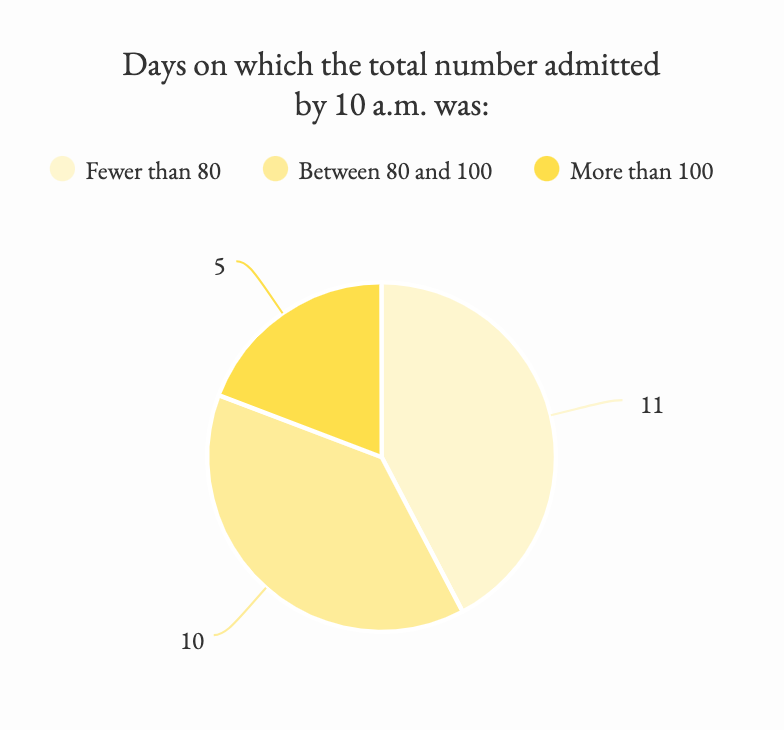 Far fewer people were left outside in the cold (literally) in December and January. On December 4, when the justices heard arguments in cases involving federal habeas corpus and ERISA, and January 15, involving an age-discrimination case, everyone standing in line got a ticket at 7:30. And only one person remained in line on January 13, when the arguments focused on trademark law and ERISA, after police officers handed out tickets at 7:30.
Far fewer people were left outside in the cold (literally) in December and January. On December 4, when the justices heard arguments in cases involving federal habeas corpus and ERISA, and January 15, involving an age-discrimination case, everyone standing in line got a ticket at 7:30. And only one person remained in line on January 13, when the arguments focused on trademark law and ERISA, after police officers handed out tickets at 7:30.
Although members of the public who do not get tickets at 7:30 will, as explained above, normally have a second chance at getting into the courtroom, the number of people who are shut out when tickets are initially distributed at 7:30 a.m. is significant in its own right. Because of the uncertainty about how many people will be admitted in the 10 a.m. wave, some people may decide that the wait is not worth it and either go home or opt for the “three-minute” line, which all but guarantees them a brief glimpse of the proceedings. Indeed, on October 15, when the Supreme Court heard oral argument in the challenge to the constitutionality of Puerto Rico’s financial oversight board, anyone who waited in the hope of being admitted after tickets were distributed at 7:30 a.m. would have been out of luck, because the court did not admit anyone else from the public line after that.
The median number of people admitted to the courtroom in total by the time arguments began at 10 a.m., including the people who obtained tickets at 7:30 a.m., was 85. The highest number of people admitted from the public line by 10 a.m. was 144 on December 3, when the justices heard arguments in cases involving federal tax laws and the federal Superfund law.
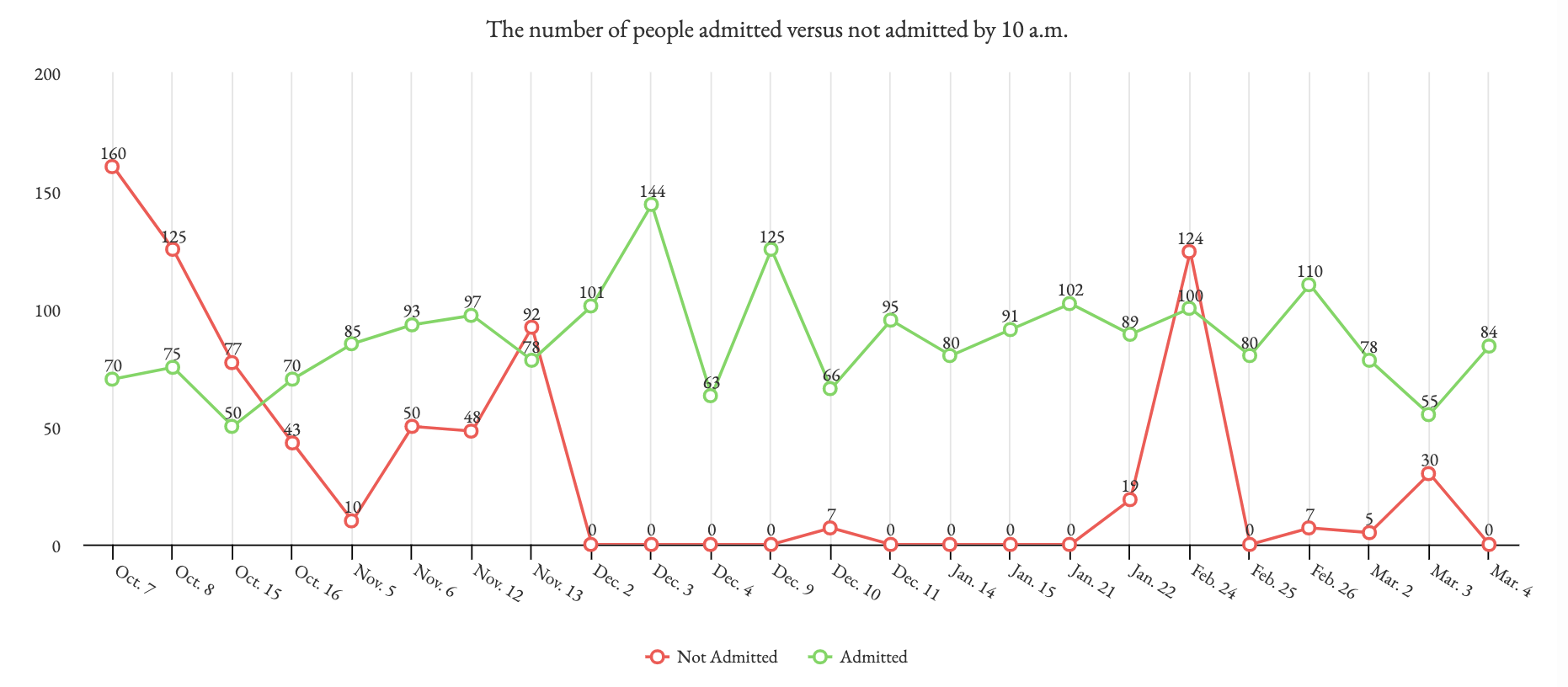
In the chart above, red refers to those in line at 7 a.m. who would not have been admitted by 10 a.m., assuming no attrition in the line.
3. Conclusion
To a certain extent, the data confirms what we would have expected: There is no “one size fits all” way to determine the likelihood of getting a seat through the public line. A lot of factors come into play, including the cases being argued, the number of seats that are available (which, unfortunately, the public doesn’t know in advance) and even the weather: Heavy rain on the day of a rare afternoon argument meant that you could show up at 12:20 p.m. and still snag a seat for the 1 p.m. argument in the “D.C. sniper” case on October 16. A similar scenario played out on December 10, when the justices heard oral argument in the Affordable Care Act “risk corridors” case: Getting one of the tickets distributed at 7:30 a.m. would have required a 5 a.m. arrival, but heavy rain set in later in the morning and likely drove away people who might have otherwise planned to wait, allowing some would-be spectators to arrive shortly before 10 a.m. and still get a seat in the courtroom.
What we do know is that for many cases at the court this term, particularly the higher-profile ones, the demand for public seats outstripped the supply. On five argument days this term, more than half the people who waited in line would not get a seat. In four other cases, approximately a third of the people who waited in line ultimately would not get in for the argument. By contrast, some cases were more accessible, particularly in December and January. Even on days when there may have initially been long lines, the combination of bad weather and uncertainty about how many seats would be available may have led to some attrition: If you were willing to wait in line until 10 a.m., your chances of getting in eventually were extremely high.
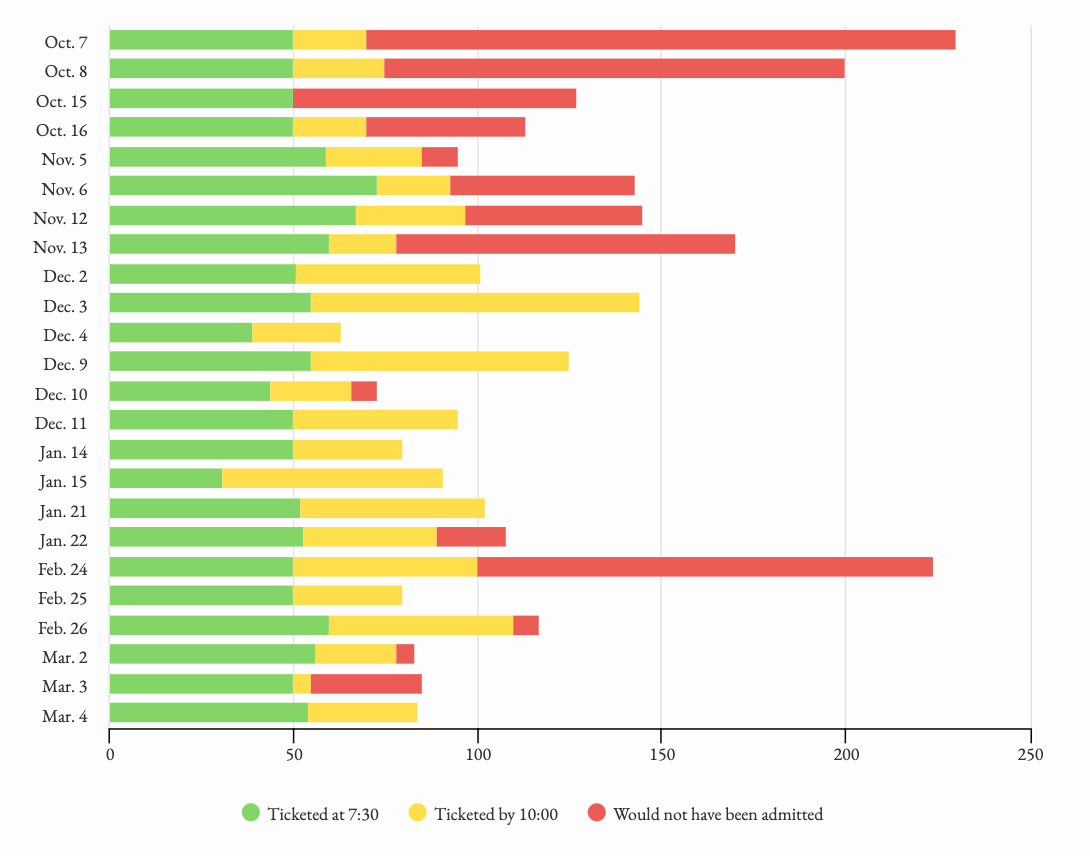
In the charts above and below, red is the number in line at 7 a.m. who would not have made it in by 10 a.m., assuming no attrition in the line. On Oct. 8, a bomb scare scattered the line, so we had to estimate 75 admitted by 10 a.m. based on a rough count. Incomplete data obtained on Nov. 4 and Jan. 14.
If your goal is simply to see the Supreme Court in action, and you have some flexibility in your schedule, our data shows that it is possible to do without spending long hours on the sidewalk, as long as you are willing to brave rainy or wintry weather and skip the high-profile arguments. But many people want to go to the Supreme Court to see a particular argument, because the case presents an issue that they have a connection to. And seats for those cases, as the stories we have collected this term suggest and the data bears out, can often be significantly harder to obtain.
On Thursday: A closer look at the separate line for lawyers wanting to attend arguments.
This post was originally published at Howe on the Court.



